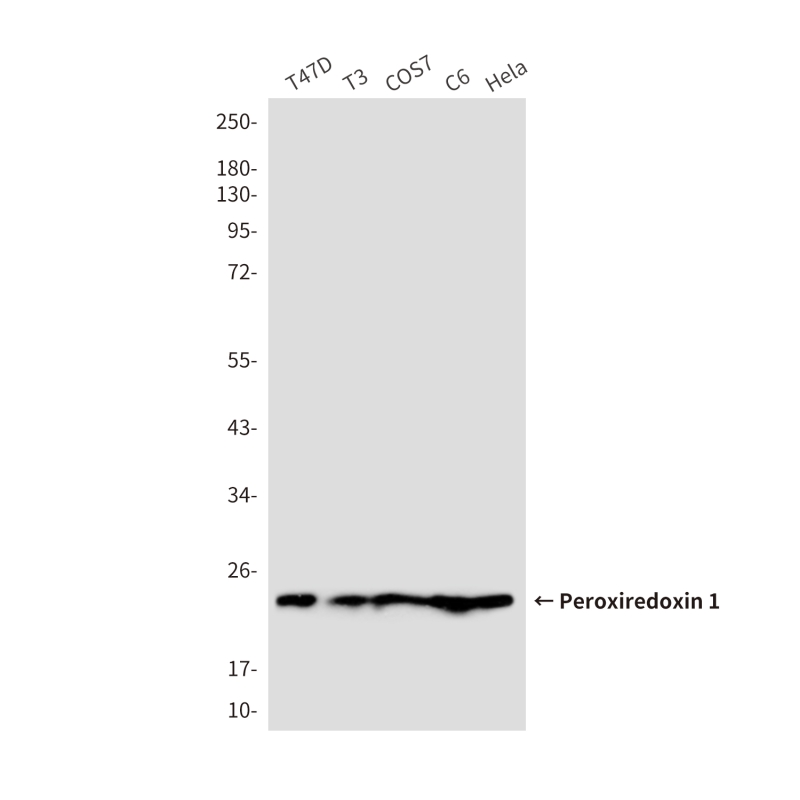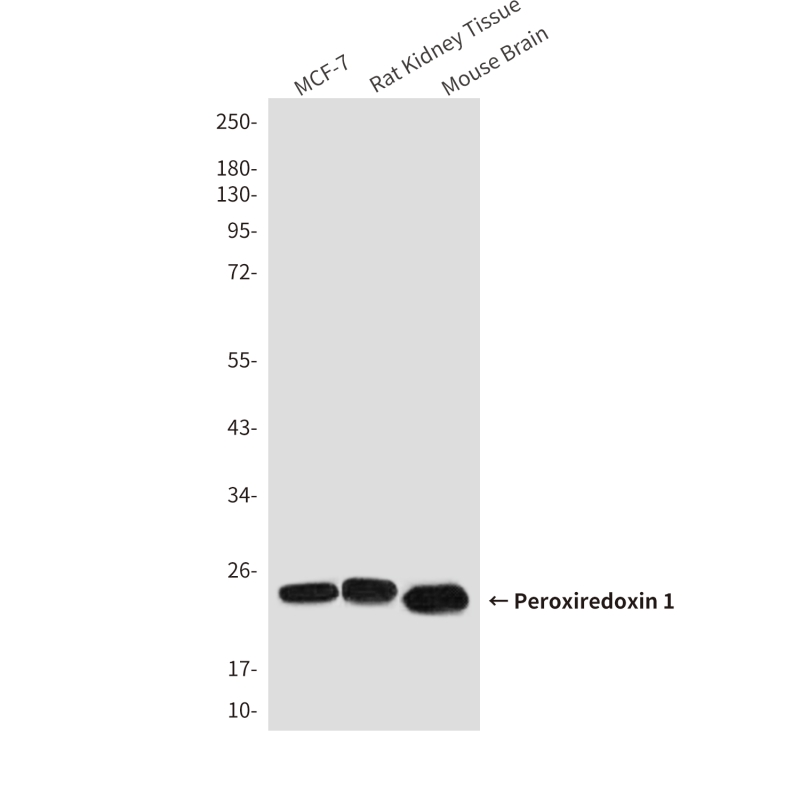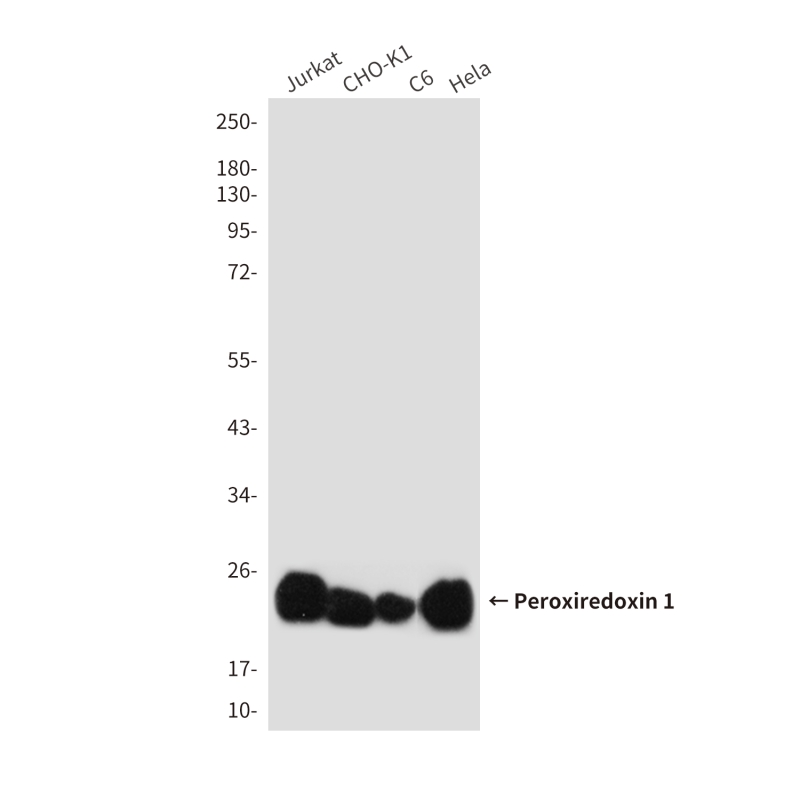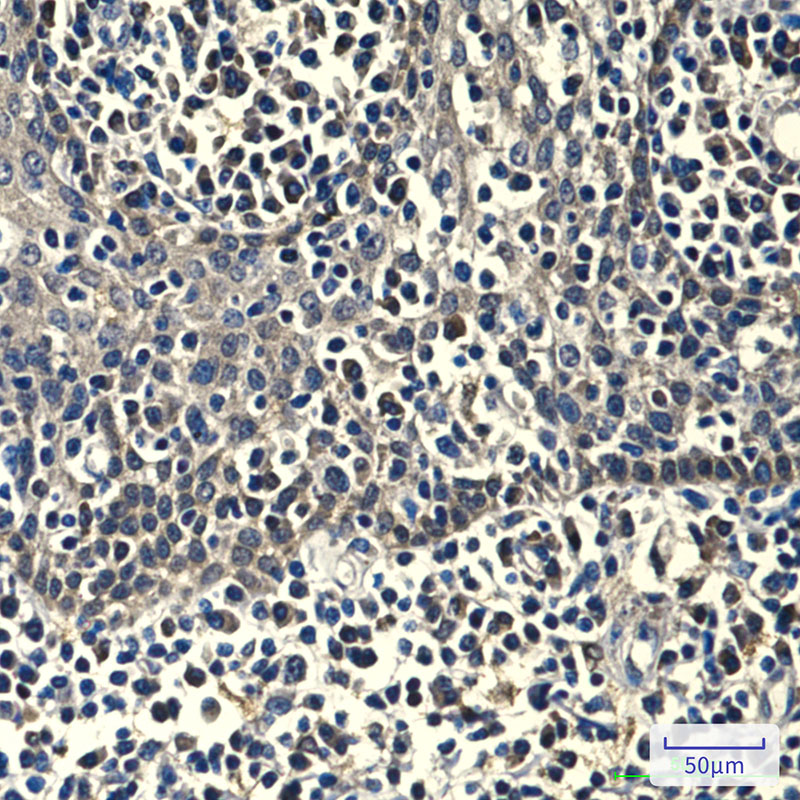




| WB | 咨询技术 | Human,Mouse,Rat |
| IF | 咨询技术 | Human,Mouse,Rat |
| IHC | 1/50-1/100 | Human,Mouse,Rat |
| ICC | 1/50-1/200 | Human,Mouse,Rat |
| FCM | 咨询技术 | Human,Mouse,Rat |
| Elisa | 咨询技术 | Human,Mouse,Rat |
| Aliases | PRDX1; PAGA; PAGB; TDPX2; Peroxiredoxin-1; Natural killer cell-enhancing factor A; NKEF-A; Proliferation-associated gene protein; PAG; Thioredoxin peroxidase 2; Thioredoxin-dependent peroxide reductase 2 |
| Entrez GeneID | 5052 |
| clone | 5C6 |
| WB Predicted band size | Calculated MW: 22 kDa; Observed MW: 22 kDa |
| Host/Isotype | Mouse IgG1 |
| Antibody Type | Primary antibody |
| Storage | Store at 4°C short term. Aliquot and store at -20°C long term. Avoid freeze/thaw cycles. |
| Species Reactivity | Human,Mouse,Rat |
| Immunogen | Recombinant Protein of Peroxiredoxin-1 |
| Formulation | Purified antibody in PBS with 0.05% sodium azide,0.5%BSA and 50% glycerol. |
+ +
以下是关于Peroxiredoxin 1(PRDX1)抗体的3篇参考文献示例(文献名称、作者及摘要概括):
---
1. **文献名称**: *"Peroxiredoxin 1 functions as a signal peroxidase to sense and regulate oxidative stress"*
**作者**: Woo HA et al.
**摘要**: 本研究揭示了PRDX1在氧化应激信号传导中的核心作用,利用特异性抗体证实其通过氧化还原敏感的半胱氨酸残基感知H₂O₂,并调控下游通路(如NF-κB和MAPK),为抗氧化防御机制提供了新见解。
---
2. **文献名称**: *"High expression of peroxiredoxin 1 is associated with aggressive prostate cancer"*
**作者**: Park SY et al.
**摘要**: 通过免疫组化(使用PRDX1特异性抗体)分析前列腺癌组织,发现PRDX1高表达与肿瘤侵袭性及不良预后显著相关,提示其可作为癌症进展的生物标志物。
---
3. **文献名称**: *"Antibody-based validation of PRDX1 isoforms in neurodegenerative disease models"*
**作者**: Lee JH et al.
**摘要**: 研究利用多种PRDX1抗体(包括针对磷酸化修饰的抗体)在阿尔茨海默病模型中验证了PRDX1的亚型差异表达,发现其过度氧化与神经元损伤相关,为神经退行性疾病的氧化损伤机制提供证据。
---
注:以上文献为示例,实际引用时需根据具体研究领域核实原文。建议通过PubMed或Google Scholar搜索关键词“Peroxiredoxin 1 antibody”获取最新或高引论文。
Peroxiredoxin 1 (Prx1) is a ubiquitously expressed antioxidant enzyme belonging to the peroxiredoxin family, which plays a critical role in regulating cellular redox homeostasis by scavenging reactive oxygen species (ROS), particularly hydrogen peroxide. Prx1 is involved in diverse cellular processes, including cell proliferation, apoptosis, and inflammation, and its dysregulation has been linked to cancer, neurodegenerative diseases, and aging. Structurally, Prx1 contains a conserved peroxidatic cysteine residue that undergoes oxidation during catalysis, followed by recycling via thioredoxin-dependent reduction.
Antibodies targeting Prx1 are essential tools for studying its expression, localization, and functional roles in biological systems. These antibodies are widely used in techniques such as Western blotting, immunohistochemistry (IHC), and immunofluorescence (IF) to detect Prx1 levels in tissues or cultured cells. Given its relevance in oxidative stress responses, Prx1 antibodies are particularly valuable in research on diseases associated with ROS imbalance. For example, elevated Prx1 expression has been observed in various cancers, correlating with tumor progression and chemoresistance, while reduced levels are implicated in neurodegenerative conditions.
When selecting a Prx1 antibody, specificity validation (e.g., knockout controls) is crucial due to potential cross-reactivity with other peroxiredoxin family members. Commercial antibodies are typically raised in rabbits or mice, with monoclonal and polyclonal options available. Researchers should optimize experimental conditions based on sample type and application to ensure reliable results. Overall, Prx1 antibodies serve as indispensable reagents for exploring oxidative stress mechanisms and developing therapeutic strategies targeting redox signaling pathways.
×